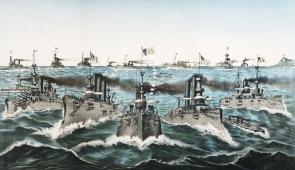Our Victorious Fleets in Cuban Waters, 1898
A Spotlight on a Primary Source by Currier & Ives
 In 1898, the US Navy was small—especially compared to the navies of the European powers. The Navy had shrunk in the years after the Civil War, from more than 600 vessels at that conflict’s close to just forty-eight ready but aging vessels in 1879. During the 1880s a number of new warships were authorized with the start of a naval modernization effort intended to protect America’s expanding global interests. Further modernization and growth took place after the 1890 publication of naval strategist and historian Alfred Thayer Mahan’s The Influence of Sea Power upon History, which argued that naval superiority was necessary for a nation to be a true global power.
In 1898, the US Navy was small—especially compared to the navies of the European powers. The Navy had shrunk in the years after the Civil War, from more than 600 vessels at that conflict’s close to just forty-eight ready but aging vessels in 1879. During the 1880s a number of new warships were authorized with the start of a naval modernization effort intended to protect America’s expanding global interests. Further modernization and growth took place after the 1890 publication of naval strategist and historian Alfred Thayer Mahan’s The Influence of Sea Power upon History, which argued that naval superiority was necessary for a nation to be a true global power.
When it became clear in 1898 that the US might soon intervene for Cuba in its struggle for independence from Spain, the Navy was still a relatively small force, despite almost two decades of modernization. Americans understood that the conflict—the Spanish American War—would necessitate a major naval force, and in March of 1898 Congress passed a bill providing $50 million for defense. The Navy spent more than $21 million of that money to purchase 102 new and private vessels to bolster the existing eighty-six in its fleet.
This 1898 Currier & Ives print, "Our Victorious Fleets in Cuban Waters," portrays American naval forces that served off Cuba during the Spanish American War. (It is also the last-known print produced by Currier & Ives.) Among the vessels featured in the print are the Iowa, the largest battleship in the American fleet, and the cruiser New Orleans, a highly modern warship and one of the two most expensive auxiliary vessels purchased in 1898.
